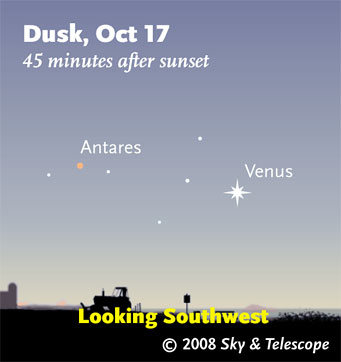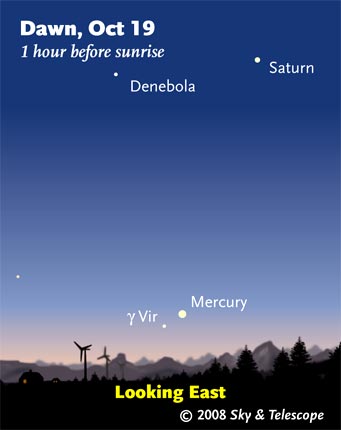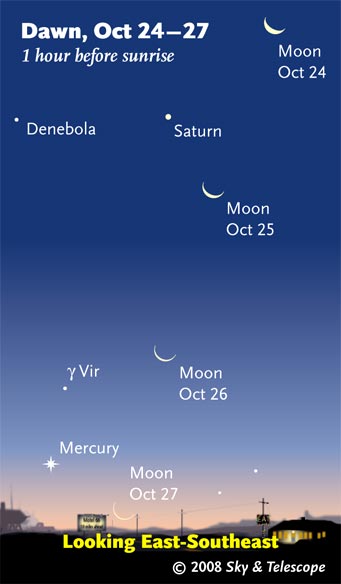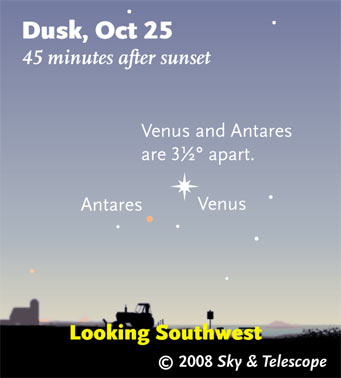Some daily events in the changing sky for October 17 – November 25.

All week, Venus is getting higher and easier to spot after sunset. Look for Antares, much fainter, moving in toward Venus from the left. Binoculars will help.
Sky & Telescope diagram
Friday, October 17
Saturday, October 18
Sunday, October 19

Mercury is up before sunrise and brightening day by day. Look for it low in the dawn, far below Saturn.
Sky & Telescope diagram
Monday, October 20
Tuesday, October 21
Wednesday, October 22
Thursday, October 23

Watch the Moon waning from morning to morning is it passes Saturn and, later, low Mercury. (These scenes are drawn for the middle of North America. European observers: move each Moon symbol a quarter of the way toward the one for the previous date. For clarity, the Moon is shown three times actual size.)
Alan MacRobert
Friday, October 24
Saturday, October 25
Want to become a better amateur astronomer? Learn your way around the constellations. They're the key to locating everything fainter and deeper to hunt with binoculars or a telescope. For an easy-to-use constellation guide covering the whole evening sky, use the big monthly foldout map in each issue of Sky & Telescope, the essential magazine of astronomy. Or download our free Getting Started in Astronomy booklet (which only has bimonthly maps).
Once you get a telescope, to put it to good use you'll need a detailed, large-scale sky atlas (set of maps; the standards are Sky Atlas 2000.0 or the smaller Pocket Sky Atlas) and good deep-sky guidebooks (such as Sky Atlas 2000.0 Companion by Strong and Sinnott, the even more detailed Night Sky Observer's Guide by Kepple and Sanner, or the classic Burnham's Celestial Handbook). Read how to use them effectively.
Can a computerized telescope take their place? As Terence Dickinson and Alan Dyer say in their Backyard Astronomer's Guide, "A full appreciation of the universe cannot come without developing the skills to find things in the sky and understanding how the sky works. This knowledge comes only by spending time under the stars with star maps in hand and a curious mind." Without these, they wisely say, "the sky never becomes a friendly place."
More beginners' tips: "How to Start Right in Astronomy".
This Week's Planet Roundup
Mercury, which brightens from magnitude 0.0 to –0.8 this week, is coming into its best morning apparition of 2008. Look for it low in the east, far below Saturn, about 60 to 45 minutes before sunrise. (You can always find your local sunrise time, and much else, once you put your location into our online almanac. If you're on daylight saving time like most of North America, make sure the Daylight Saving Time box is checked.)

Near Venus, Can you still see Antares through the sunset afterglow?
Alan MacRobert
Venus (magnitude –3.8) is slowly becoming more prominent after sunset. Look for it above the southwest horizon in twilight, about 45 to 60 minutes after sundown. Binoculars hill help you spot Antares to Venus's left or, later in the week, lower left.
Mars is lost in the sunset.
Vesta, the brightest asteroid, is easily spottable with binoculars at magnitude 6.5 in the head of Cetus. It gets high late in the evening. Use the finder chart in the November Sky & Telescope, page 67.
Jupiter (magnitude –2.2, in Sagittarius) shines highest in the south-southwest in twilight, and lower in the southwest later — so get your scope on it early! Once night arrives, you'll see that Jupiter is above the sinking Sagittarius Teapot and below the smaller, dimmer Teaspoon.
Saturn shines in the east at dawn. Don't confuse it with fainter Regulus higher up. A telescope will show that Saturn's rings have turned nearly edge on; they're currently tilted 2.5° to our line of sight and closing. They'll reach a minimum of 0.8° at the end of the year, then start opening again.
Uranus and Neptune (magnitudes 5.7 and 7.9, respectively, in Aquarius and Capricornus) are in the southeast and south during evening. Use our article and finder charts or the chart in the September Sky & Telescope, page 63.
Pluto (magnitude 14.0, in the northwestern corner of Sagittarius) sinks in the southwest after dark.
All descriptions that relate to your horizon or zenith — including the words up, down, right, and left — are written for the world's mid-northern latitudes. Descriptions that also depend on longitude (mainly Moon positions) are for North America. Eastern Daylight Time (EDT) equals Universal Time (known as UT, UTC, or GMT) minus 4 hours.
To be sure to get the current Sky at a Glance, bookmark this URL:
http://SkyandTelescope.com/observing/ataglance?1=1
If pictures fail to load, refresh the page. If they still fail to load, change the 1 at the end of this URL to any other character and try again.
 0
0
Comments
You must be logged in to post a comment.